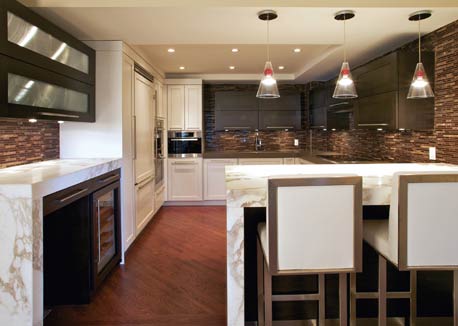Top Ten Design Trends for 2010 Revealed

May 21, 2010
What’s the look for 2010? The National Kitchen & Bath Association has announced the top 10 design trends from the 2010 NKBA Design Competition, which revealed its winners on April 16th at the 2010 Kitchen & Bath Industry Show in Chicago.
Concealed kitchens will be a popular look as kitchen design has reached a new level of integration. The incorporation of the kitchen into the home’s primary living and entertaining rooms provides homeowners with far more flexibility in their lifestyles. Integrated and concealed appliances now allow the kitchen to enhance rather than intrude into other spaces. Also showing up in kitchens are beverage stations, an area usually comprised of an undercounter refrigerator and wine refrigeration, as well as a coffeemaker. These provide a functional destination within the kitchen and may sometimes have a smaller bar area.
The competition found that the overall composition of kitchens and baths is being defined by a sense of scale, which is both functional and visually appealing. An irregularly textured pebbled wall, marbled surface in glass tile, reflective metallic material, or symmetrically hung pendant lighting directs the eye around the room and contributes to a balanced space. Distinctive wall coverings, tin ceilings and the implied texture of a pronounced wood grain are all details that are being seen as contributors to the balanced scale of current designs.
Bold colors are creating a vibrant splash in room palettes for 2010, with blues, purples, greens, and citric yellow making their appearance in kitchens and baths. Colors from nature combined with others more synthetically blended, are inducing a feeling of movement and motion throughout the room through sharp contrasts.
Softer geometry such as rounded organic shapes seen on the edge of a counter or island top, an arch over an entryway or cooking hearth, and the curved lines of a light fixture is showing up in the kitchen. This trend is being seen in contemporary and traditional designs alike. Additionally, fixtures once confined by location are now incorporated into kitchen and bath designs in almost limitless ways. Floating vanities and wall-mounted toilets allow an unobstructed and spacious feel to a bathroom, while appliances that are stacked and positioned within islands are contributing to functionality in the kitchen by bringing together task space with the right appliances.
Design framing is being used as a desired device. (See pictured: Design by Tanya Rentzos, Andros Kitchen & Bath Design, Mississauga, ON. Photo by Averill Lehan/Pro Active Imaging). A seemingly simple detail, such as the use of a soffit along the ceiling or a width of wall space surrounding inset cabinetry, can call out the item being framed as a focal point while also providing visual balance to the room. Balance in design is achieved not only by the use of symmetry, instead portions of a room can be treated as a piece of art, with a frame indicating its presence.
Varying height island tops, countertops, and partial walls is trendy right now with surfaces being customized to the task performed and to the needs of the homeowners. Pairing lower desk and prep areas with higher breakfast bar surfaces provides convenient task-specific spaces, which fosters a greater level of family interaction within the kitchen. In the bathroom, this design concept not only provides function, but balances the space.
Japanese influences remain fashionable with the use of clean lines, open spaces, and neutral color palettes with bold splashes of color in select areas. The style is showing up in designs across North America, relying often on one strong anchor piece of Japanese origin. Artwork, antiques, and the traditional qualities of Japanese culture are at the core of some compelling kitchen and bath designs.
The final trend identified is art integration, which provides an intense level of personalization in kitchen and bath design. The introduction of a favored piece of art—perhaps a framed painting or an antique sculpture—as the basis for a design creates challenges, but also offers guidelines and solutions to color and material choices, as well as selections of theme. As artwork itself is personal to the owner, this presents an immediately intimate quality to the space.
More News
April 23, 2024 | Trends & Inspirations
Sustainability Report: More Education Needed for Green K&B Design
April 22, 2024 | Awards & Events, Trends & Inspirations
A Look Inside the 2024 Atlanta Homes & Lifestyles Southeastern Designer Showhouse
April 22, 2024 | KBB Collective
Top Designer Shares Favorite KBIS 2024 Products
April 22, 2024 | Trends & Inspirations
Survey: Nearly Half of Homeowners Invest in Green Plumbing
April 21, 2024 | Business
ADJ Interiors Moves Offices
April 2, 2024 | Sponsored
Whirlpool Corp. Brings Purposeful Innovation Home